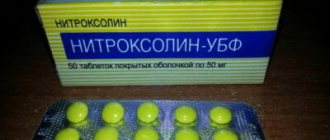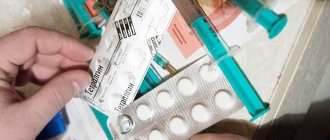Release form and composition
The dosage form of Reladorm is tablets: flat-cylindrical, round, white or grayish-white, chamfered on both sides, with a score line on one side (10 pcs. in blister and non-blister packs, 1 pack in a cardboard box).
Active ingredients in 1 tablet:
- Diazepam – 10 mg;
- Calcium cyclobarbital – 100 mg.
Additional components: sodium carboxymethyl starch, potato starch, gelatin, talc, lactose monohydrate.
Reladorm analogues
Corvalol
Pharmstandard-Leksredstva, Russia
The average cost is 20 rubles per bottle.
Corvalol is the most popular sedative medication. Its advantages are speed, low cost and availability. The drops have a dispenser through which you can easily measure out the required amount. With the help of Corvalol it is appropriate to eliminate heart attacks, vascular spasms, insomnia, increased nervousness or irritability. The drug is characterized by a very persistent and pungent odor, which, even after opening the bottle once, can be felt for a long period in the room. In normal dosages, the medicine is well tolerated. Rarely causes nausea.
Pros:
- Cheap drug
- Helps quickly.
Minuses:
- Possible addiction
- Contains barbiturate.
Bellataminal
CJSC Pharmcenter Vilar, Russia
The average cost is 140 rubles per package.
Bellataminal is a combination medicine consisting of a mixture of belladonna, phenobarbital and ergotamine. Using a combination of these substances, it is possible to achieve a lasting therapeutic effect in the treatment of neurosis-like conditions, insomnia, and autonomic disorders during the height of climatic syndrome. As part of complex treatment, bellataminal is effective in the treatment of concussion and atopic dermatitis.
Pros:
- Combined effect
- Tangible action.
Minuses:
- There are more effective analogues
- Not the cheapest.
Korvaltab
Pharma Start LLC, Ukraine
The average cost in Russia is 60 rubles per package.
Corvaltab is a tablet form of regular Corvalol. One package can sell 1 or 2 blisters, each containing 10 tablets. They are round and have a characteristic corvalolic odor, which is produced by mint oil in combination with bromoisovaleric acid. The indications for use in the tablet analogue are no different from the oral liquid form.
Pros:
- Inexpensive
- Does not contain alcohol.
Minuses:
- Drops are 3 times cheaper
- Not suitable for everyone.
Contraindications
Absolute:
- Severe respiratory failure (regardless of the cause);
- Sleep apnea syndrome;
- Hereditary lactose intolerance, Lapp lactase deficiency or glucose-galactose malabsorption;
- Severe renal/liver failure;
- Glaucoma;
- Myasthenia gravis (myasthenia gravis);
- Acute porphyria;
- Poisoning with alcohol or drugs with a depressing effect on the central nervous system;
- Children and elderly (from 65 years old) age;
- Pregnancy and lactation;
- Hypersensitivity to the components of the drug, as well as to derivatives of 1,4-benzodiazepine and barbituric acid.
Relative (Reladorm should be taken with caution in the presence of the following diseases/conditions):
- Moderate or mild renal/liver failure;
- Chronic respiratory failure;
- Mild forms of porphyria;
- Depression;
- History of suicidal thoughts and attempts;
- History of drug, alcohol or drug addiction.
The use of Reladorm in patients with psychosis is not recommended.
During the therapy period, as well as for 3 days after the end of the course, you should not drink alcohol.
Reladorm
Reladorm is a combined sleeping pill.
Release form and composition
Dosage form - tablets: round, flat-cylindrical, white or white-grayish in color, chamfered on both sides, with a score on one side (10 pieces in blisters, 1 blister in a cardboard box, equipped with tamper evident stickers).
Active ingredients:
- Calcium cyclobarbital – 100 mg;
- Diazepam – 10 mg.
Auxiliary components: gelatin, talc, sodium carboxymethyl starch, potato starch, lactose monohydrate.
Reladorm is a drug used for the symptomatic treatment of sleep disorders of various etiologies.
Terms and conditions of storage
Store in a dry place, protected from light, out of reach of children at temperatures up to 25 °C.
Shelf life – 3 years.
Found an error in the text? Select it and press Ctrl + Enter.
Source: https://spravka03.net/reladorm.html
Directions for use and dosage
Reladorm is taken orally; it is recommended to take the tablets with a small amount of water.
The duration of therapy and dosage regimen must strictly comply with the doctor's instructions. Typically, adults are recommended to take the drug 1 hour before bedtime in a dose of ½-1 tablet, the course is no more than 7 days.
With longer use (for example, for 14 days), drug dependence may develop. In such cases, therapy should not be abruptly stopped; the dose should be reduced gradually under the supervision of a physician.
For moderate or mild liver and/or kidney dysfunction, take ½ tablet.
If you miss the next dose, you must take the missed tablet as quickly as possible or, if a lot of time has passed since the missed dose and it is time for the next dose, continue therapy according to the prescribed regimen.
Do not use a double dose!
Composition and release form
This drug is produced in tablet form and has two active ingredients - diazepam (0.01 grams in one tablet) and cyclobarbital calcium salt (0.1 grams in one tablet).
Reladorm tablets contain the following substances as auxiliary components: gelatin, lactose, talc, potato starch, sodium starch glycolate.
Tablets of ten pieces are packaged in pharmacological blisters or strips. One cardboard package contains one blister or strip and instructions.
Contraindications for use
There are a number of contraindications, that is, patient conditions in which taking Reladorm is not recommended or prohibited. These include:
- individual hypersensitivity to any component included in the drug;
- pronounced respiratory failure of various etiologies;
- glaucoma;
- porphyria;
- myasthenia gravis;
- sleep apnea syndrome;
- alcohol poisoning;
- intoxication of the body resulting from taking drugs that depress the central nervous system;
- all children's age groups;
- period of pregnancy and breastfeeding;
- old age after sixty-five years.
Use during pregnancy and lactation
As can be seen above, lactation and pregnancy are contraindications for taking Reladorm. If it is necessary to use this drug, you should stop breastfeeding the baby to avoid the development of withdrawal syndrome in the child.
Interaction with other drugs
The action in the body of Reladorm is enhanced by drugs belonging to the narcotic group of analgesics, antihypertensive drugs of central action, neuroleptic drugs, antihistamines and anti-epileptic drugs.
Drinking alcohol during therapy with Reladorm enhances the process of depression of the central nervous system, and the development of paradoxical reactions such as psychomotor agitation, pathological intoxication, aggression, and deep mental depression is possible.
According to the instructions included with this drug, it reduces the severity of the effects of contraceptives, griseofulvin, hypoglycemic agents, anticoagulants and doxycycline.
Special instructions for use
Therapy with Reladorm should be carried out under the strict supervision of the attending physician. If the patient has such phenomena as liver or kidney failure, Reladorm is prescribed in minimal dosages with maximum caution.
If the drug is used for a long period of time, it is important to periodically monitor liver test results (or biochemical blood tests).
If paradoxical reactions of the body develop while taking this drug, it is necessary to immediately stop using it.
If other drugs are prescribed while taking Reladorm, consultation with your doctor is necessary to avoid the occurrence and development of irreversible negative effects.
During treatment with Reladorm and after completion of therapy, the consumption of alcoholic beverages is prohibited for three days.
Directions for use and dosage
Reladorm is taken orally with a small amount of water. It is not recommended to take the drug for longer than 7 days.
It is necessary to strictly adhere to the dosage regimen prescribed by the doctor.
As a rule, adults are prescribed Reladorm ½ or 1 tablet an hour before bedtime.
For mild to moderate renal/liver failure, take the lowest recommended dose (½ tablet).
Taking Reladorm longer than prescribed (for example, for several weeks) may cause drug dependence. In this case, it is impossible to abruptly interrupt therapy due to the likelihood of developing withdrawal syndrome in the form of sleep and mood disorders, disturbances of attention and concentration, and increased irritability (a gradual, doctor-controlled dose reduction is required).
If you miss a single dose, you should take it as soon as possible or skip it. You cannot double the dose.
Contraindications and precautions
The drug should not be prescribed if there is an individual intolerance to the active ingredients. The medicine is not used in pregnant women, breastfeeding women, mentally ill persons suffering from suicidal tendencies, attention deficit disorder, muscle asthenia, functional liver or kidney failure, porphyria, or elevated levels of potassium in the blood. The medication is also not prescribed to elderly and minors.
Cross-drug interactions
The drug potentiates the effectiveness of antidepressants, sedatives, antipsychotics and opioid painkillers. IMOs increase the rate of removal of the drug from the body by approximately 2 times. The drug disrupts metabolic processes when phenytoin enters the body. Also, the medicine is not taken together with oral combined contraceptives (progestin and estrogen components), alcohol, griseofulvin, doxycycline, warfarin, heparin, as well as glucocortisteroid hormones.
Side effects
The severity and frequency of adverse reactions depend on the individual sensitivity of the patient and the dose of Reladorm.
The most common side effects include: ataxia, dizziness, headache, drowsiness, slowing of psychomotor functions, disorientation, confusion.
In more rare cases, the development of such disorders as general weakness, a feeling of dry mouth, fainting, visual disturbances (in the form of blurred vision, diplopia), dysarthria (in the form of slurred speech and incorrect pronunciation), liver dysfunction, memory impairment, gastrointestinal tract - intestinal disorders, muscle tremors, libido disorders, menstrual disorders, changes in the morphological composition of the blood (agranulocytosis, leukopenia), slight decrease in blood pressure, urinary incontinence, skin allergic reactions, paradoxical reactions (in the form of psychomotor agitation, insomnia, increased excitability and aggressiveness , muscle tremors, seizures; most often develop with alcohol consumption, in elderly patients and in patients with mental illness).
The reasons for discontinuation of therapy are: increased activity of liver enzymes, anuria, visual impairment, dysfunction of the hematopoietic system, jaundice.
Systematic use of Reladorm for longer than the period recommended in the instructions can lead to the development of drug dependence, and sudden discontinuation of therapy can lead to withdrawal syndrome.
Overdose
In case of an overdose of the drug, the following symptoms may occur:
- speech disorder;
- death due to severe overdose;
- feeling drowsy;
- change in consciousness;
- drop in blood pressure;
- breathing disorder.
In case of overdose, you should immediately induce vomiting and consult a doctor.
The antidote for Reladorm is Flumazenil. When taken in a timely manner, it effectively combats the symptoms of overdose.
special instructions
Before prescribing Reladorm, you need to carefully analyze the existing disorders, excluding other possible causes of insomnia (psychogenic, somatogenic, bad habits).
Patients should be closely monitored during therapy.
The risk of developing drug dependence is dose-dependent. The likelihood of this disorder increases in patients with a history of dependence on other drugs, in patients with alcohol dependence, and also with long-term use of the drug. The potential for developing drug dependence increases when combined with cyclobarbital.
Abrupt cessation of therapy against the background of drug addiction can lead to the development of withdrawal syndrome (characteristic symptoms: headache and muscle pain, emotional tension, psychomotor agitation, disorientation, insomnia, restlessness, confusion, increased irritability). In severe cases, the following may occur: loss of a sense of the reality of the environment, personality disorders, increased sensitivity to touch, visual and auditory stimuli, numbness of the limbs, a feeling of “crawling”, seizures, hallucinations.
Reladorm can lead to the development of antegrade amnesia (in most cases, several hours after administration, especially after taking a large dose of the drug). It is recommended to provide conditions for uninterrupted 7-8 hours of sleep, and also take Reladorm 60 minutes before bedtime.
If symptoms of paradoxical reactions appear, therapy is discontinued.
Due to the likelihood of developing suicidal thoughts, the drug should be prescribed with caution to patients with symptoms of endogenous depression (the recommended daily dose is ½ tablet). Caution also requires the use of Reladorm in patients prone to suicidal actions (possible deterioration of the condition), with a mild form of porphyria (possible intensification of symptoms).
Periodically during therapy, it is necessary to conduct studies of the morphological composition of peripheral blood, as well as functional liver tests.
You cannot drive a vehicle or perform other potentially dangerous work that requires increased concentration and rapid psychomotor reactions while taking Reladorm, as well as for 3 days after its withdrawal.
Similar drugs:
- Novo-Passit Oral tablets
- Phenazepam Solution for intravenous and intramuscular administration
- Valz Oral tablets
- Relanium Solution for intravenous and intramuscular administration
- Elenium (Eldisine) Oral tablets
- Nozepam Oral tablets
- Valocordin-Doxylamine Drops for oral administration
- Zaleplon Substance-powder
- Radedorm 5 Oral tablets
- Promedolum Solution for injection
** The Drug Directory is intended for informational purposes only. For more complete information, please refer to the manufacturer's instructions. Do not self-medicate; Before starting to use the drug Reladorm, you should consult a doctor. EUROLAB is not responsible for the consequences caused by the use of information posted on the portal. Any information on the site does not replace medical advice and cannot serve as a guarantee of the positive effect of the drug.
Are you interested in the drug Reladorm? Do you want to know more detailed information or do you need a doctor's examination? Or do you need an inspection? You can make an appointment with a doctor - the Euro lab is always at your service! The best doctors will examine you, advise you, provide the necessary assistance and make a diagnosis. You can also call a doctor at home . Euro lab clinic is open for you around the clock.
** Attention! The information presented in this medication guide is intended for medical professionals and should not be used as a basis for self-medication. The description of the drug Reladorm is provided for informational purposes and is not intended for prescribing treatment without the participation of a doctor. Patients need to consult a specialist!
If you are interested in any other drugs and medications, their descriptions and instructions for use, information about the composition and form of release, indications for use and side effects, methods of use, prices and reviews of drugs, or you have any other questions and suggestions - write to us, we will definitely try to help you.
Drug interactions
When using Reladorm in combination with certain drugs/substances, the following effects may be observed:
- Sedatives, hypnotics, antihistamines, antidepressants, narcotic analgesics, monoamine oxidase inhibitors, drugs for general anesthesia (anaesthetics), centrally acting antihypertensive drugs: increased inhibitory effect of Reladorm on the central nervous system;
- Narcotic analgesics: development of pronounced euphoria (can lead to faster development of drug dependence);
- Alcohol: strengthening of its inhibitory effect on the central nervous system, development of paradoxical reactions (in the form of psychomotor agitation, aggressive behavior, pathological intoxication or the appearance of symptoms of deep depression of brain function);
- Indirect anticoagulants - derivatives of coumarin, doxycycline, hypoglycemic drugs, griseofulvin: decrease in their effectiveness;
- Levodopa: weakening of its effect;
- Phenytoin, drugs that reduce skeletal muscle tone: enhancing their effect;
- Cimetidine, disulfiram, antifungals (for example, ketoconazole), some antibacterial drugs (for example, erythromycin), antiviral drugs (for example, ritonavir): enhanced pharmacological action of Reladorm;
- Oral contraceptives: decreased effectiveness;
- Rifampicin, theophylline and tobacco smoking: acceleration of the metabolism of diazepam and weakening of its pharmacological effect;
- Digoxin, glucocorticosteroids, cyclosporine, theophylline: increased metabolism;
- Blockers of “slow” calcium channels, alpha-blockers, angiotensin-converting enzyme inhibitors, angiotensin II receptor antagonists: increased reduction in blood pressure.






